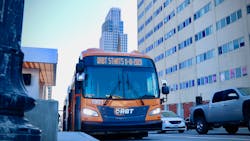On a sunny day in mid-November, palpable energy filled the air as Omaha Metro Transit (Omaha Metro) staff, 50 volunteer community transit ambassadors and transit enthusiasts alike (safely) gathered in downtown Omaha, Neb., along the Dodge Street Corridor to celebrate the long-awaited arrival of a brand-new transit service: Omaha Rapid Bus Transit (ORBT), the region’s first introduction to bus rapid transit (BRT) and one of the most significant transit investments for the area in decades.
“We had a lot of riders that hadn’t been on transit before at all, or hadn’t been on in years,” recalled Jason Rose, communications and community relations manager, Omaha Metro. “People were just amazed [by] the system.”
The service launch followed a prerecorded virtual ribbon cutting ceremony that featured videos of key project stakeholders, along with an in-person media-only ribbon cutting followed by a media-only first ride. While opening day went as virtual as possible, Omaha Metro still encouraged people to come out and see ORBT for themselves (while practicing CDC and local safety guidelines).
“It was exactly what I had hoped it would be. And the fact that I got to do the ribbon cutting myself and be on that first ride in an official role was more than I hoped for,” Cencic added, reflecting on her initial role with the ORBT project as a project manager and then coming back to Omaha Metro after a stint in Los Angeles to serve as Omaha Metro’s CEO.
Even after the ribbons had been cut and opening weekend came and went, the excitement and enthusiasm for ORBT lives on not just at Omaha Metro Transit but within the community, as well.
“Just this month, I’ve had several presentation requests [asking to give] a status update on ORBT,” said Cencic.
“It’s an ongoing thing, even after we’ve launched. [There’s] this really palpable excitement and energy,” Rose added.
Bolstering Connectivity
Drumming up this excitement took work—lots of it.
The ORBT project dates back to 2014 when Omaha Metro partnered with the Metropolitan Area Planning Agency (MAPA) to conduct the Central Omaha Transit Alternatives Analysis, which examined ways to improve an under-connected corridor while bringing together the regional transit network to bolster mobility and help employment growth and economic development.
The analysis led to identifying two locally preferred alternatives, one being a nine-mile BRT route from the Westroads Mall through downtown along Dodge Street, and the other being a modern streetcar route. BRT was identified as the preferred concept since it was the fastest and easiest to implement, and coordinated well with other city and regional plans, explains Curt Simon, who served as the previous executive director of Omaha Metro throughout the majority of the ORBT project.
Cencic adds BRT along the Dodge Street Corridor also allowed the agency to take the first step in providing a better regional connection to bring people to the downtown core area and “build on that community connectivity.”
“BRT was seen as this really important piece for us because it intersected with almost every single one of the lines on our map. We called it connecting the dots at the time,” Cencic said. “It connected Westroads Mall on the western end through the University of Nebraska Medical Center, University of Nebraska Omaha and then all the major employers downtown kind of all in the straight line.”
In addition to improved connectivity, the BRT solution aimed to improve mobility by expanding the B Cycle Program with better station connections, ensuring consistent traffic flow with queue jumps and Transit Signal Priority (TSP) and balancing parking availability, all while supporting economic growth in the region.
“There was some economic development that began after ORBT was announced, wherein these developers actually cited ORBT as one of the reasons why they were relocating to that corridor. So, the corridor was really primed for this premium transit service,” said Simon.
Making the Case for ORBT
One project hurdle Omaha Metro faced early on was informing the public of what exactly BRT could do. Plus, transit investments had been stagnant in the city for a few years and the system needed a revival.
“The city had been talking about a streetcar for decades now, so people were used to hearing about it and just waiting to see something happen,” Rose said.
So, the agency embarked on a mission to educate the public and gain their trust and buy-in, with Rose describing it as a grassroots effort in the very beginning. A project stakeholder committee was created in 2015 as the genesis of getting the community involved. The committee included 30-40 representatives from nonprofits, social services, accessibility advocates and more, and remained intact from start to finish of the project. Starting with the committee, Rose and the agency made the case for a BRT route. Simon adds they also highlighted the economic development impact BRT would bring to the corridor.
“The good part of a year was trying to drive that message home and trying to [show] how this could change how people look at transit and the city of Omaha going forward,” said Simon.
Rose also hosted several community meetings with neighborhood associations, local businesses and nonprofits, high schools, universities and current riders. Once the public was sold on the BRT concept, the agency asked the public to identify their priorities for the project, which included ease of accessibility and increased frequency of service.
These needs were addressed by having level boarding of buses via raised station platforms and implementing a simple, 10-minute frequency. The agency also began soliciting feedback about what the public wanted to see with this service down to the last detail—everything from technology and passenger amenities to the interior layout of vehicles and the name and brand of the new line.
“We really made a concreted effort from start to finish to get feedback on all aspects of the project, not just where the route should be and where the stops should be, but really what it would look and feel like because we wanted a community ownership of this,” Cencic said.
After spending several years gathering feedback and gaining community support, the community’s interest and excitement peaked when construction began and they were able to finally see what was once a difficult concept to grasp come to life.
“When our main corridor in town was starting to shut down because we were building bus stations, that blew people’s mind,” said Rose.
Selling the Benefits of Transit
After presenting to major stakeholders and selling them on the concept, and specifically the large philanthropic community, Omaha Metro was able to ask them for funding, which was something new for the agency in raising funds and the philanthropic community in investing in public transit.
“They were very generous and very open to it,” said Simon. “It was so worthwhile because it helped us build relationships with those [organizations]and at the same time, better understand what their needs were so that we could do a better job in helping them and their clientele.”
Contributions from The Peter Kiewit Foundation, The Sherwood Foundation, Mutual of Omaha, Nebraska Environmental Trust and Metropolitan Utilities District all helped successfully launch ORBT.
Another funding source that was pursued thanks to Omaha Metro’s partners at Federal Transit Administration (FTA) Region 7 Office, who encouraged the agency to apply, was a Transportation Investment Generation Economic Recovery (TIGER) Grant from the U.S. Department of Transportation (USDOT). At the time, Cencic shares they thought it was a bit of a long shot.
Despite concerns, Omaha Metro received a $14.9-million grant from the program.
“[In the application], we really were able to show how we were connecting people to opportunity through jobs, schools, medical facilities and residential places all in one line that connected to the rest of the system,” said Cencic.
All Aboard ORBT
With funding secured and public feedback incorporated, the agency was ready to hit the ground running with project construction and implementation. First up was preparing for the stations and platforms with roadway improvements, which included acquiring the necessary rights-of-way, pouring the foundations for each station, replacing pavement, restriping intersections, widening sidewalks and adding ramps to ensure accessibility.
For the stations and canopies, Omaha Metro started with three design concepts which were refined based on public feedback. Once the agency hired a consulting team to produce the final station design, the team considered materials and different structural elements to ensure durability maintainability. For instance, one design started with the backs of canopies having a glass windbreak and all the columns and the roof structure used stainless steel, explains Project Manager Joy Willoughby, who led the construction of stations. By the end of the design phase, the glass panels were switched to acrylic to better prevent shattering, the base of columns had 12 inches of exposed concrete for power washing, the platform pavement was sealed with a water repellent, a snowmelt system was installed and an anti-graffiti coating went on all vertical, concrete and structural components, says Willoughby.
The station canopies themselves were manufactured and fabricated off-site at the local contractor’s facility. The contractor would come and install the two steel support beams that went into the footings and foundations. Willoughby explains they slid the column surrounds over the beams and finally craned the roof structure into place.
“Each platform was pretty identical, so one would think it’s an easy construction,” said Willoughby,” but when you have 24 small sites along the corridor, it’s not as simple of construction. There was a lot of scheduling and phasing that needed to happen along the way.”
In addition to enhanced station designs, Omaha Metro implemented technology features that were brand new to the system, such as digital interactive kiosks for people to look up schedules and touchscreens for route planning. The agency also included digital slot signs at each location that displays real-time arrival information, along with security cameras, Wi-Fi, improved lighting and an emergency phone that connects directly to the police.
Technology investments extend beyond the platform. Inside buses, riders will see real-time arrival signs and hear audio announcements for upcoming stops thanks to an upgraded vehicle locating system. On the road, buses can talk to a handful of intersections along the corridor since the city recently implemented transit signal priority, which will extend green lights if a bus is in a certain range.
Today’s Success Spurs Tomorrow’s Investments
Thanks to the success of ORBT, transit is now a frequent topic of conversation and the community is already eager to implement more ORBT routes.
“There’s energy and enthusiasm I think we haven’t had [and] we see this as an opportunity to build upon that success,” Cencic said. “We’re committed to however we grow ORBT that it’s done in a collaborative way with a lot of engagement and something that the community feels ownership, so it makes me optimistic.”
About the Author
Megan Perrero
Editor in Chief
Megan Perrero is a national award-winning B2B journalist and lover of all things transit. Currently, she is the Editor in Chief of Mass Transit magazine, where she develops and leads a multi-channel editorial strategy while reporting on the North American public transit industry.
Prior to her position with Mass Transit, Perrero was the senior communications and external relations specialist for the Shared-Use Mobility Center, where she was responsible for helping develop internal/external communications, plan the National Shared Mobility Summit and manage brand strategy and marketing campaigns.
Perrero serves as the board secretary for Latinos In Transit and is a member of the American Public Transportation Association Marketing and Communications Committee. She holds a bachelor’s degree in multimedia journalism with a concentration in magazine writing and a minor in public relations from Columbia College Chicago.

